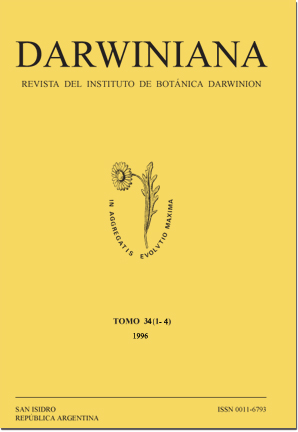Karyologieal studies in Compositae VII.
DOI:
https://doi.org/10.14522/darwiniana.2014.341-4.414Abstract
Meiotie and/or mitotic chromosome numbers were determined and observations on meiotic behavior were made in 104 accessions belonging to 75 species and 32 genera distributed in 10 tribes of the Asteraceae. One genus (Picrosia), 21 species and 2 varietes are investigated cytologically for the first time. These are as follows, tribe Mutisieae: Chaptalia graminifolia (Dus.) Cabrera and Ch. pilloselloides (Vahl.) Baker (2n = ca. 48); tribe Cichorieae: Picrosia longifolia Don (n = 7 II); tribe Astereae: Baccharis effusa Griseb. (n = 9 II), B. flabellata Hook. et Arn. (n = 9 II), B. flabellata var. argentina (Heer.) Ariza (n = 9 II), B. rhexioides H. B. K. (n = 9 II), B. tucumanensis Hook. et Arn. (n = 9 II), Grindelia buphthalmoides DC. (2n = 12); tribe Senecioneae: Senecio flagellisectus Griseb. (n = 20 II), S. grisebachii Baker var. grisebachii Baker (n = 20 II), S. lorentzii Griseb. (n = 20 II); tribe Heliantheae: Calea clematidea Baker (n = 19 II), Cosmos marginatus Klatt (n = 24 II), Spilanthes alpestris Griseb. (n = ca. 14 II), Tridax paraguayensis Kuntze (n = 18 II); tribe Eupatorieae: Eupatorium buniifolium Hook. et Arn. (2n = 20 + 2B), E. lorentzii Hieron. (n = ca. 17 II), E. grosidentatum Hieron. (n = 10 II), Ophryosporus macrodon Griseb. (n = 10 II), Pterocaulon lanatum O. K. (n = 11 II), Stevia aff. effusa Hieron. (n = 11 II) and S. maimarensis (Hieron.) Cabrera (n = 11 II). Different chromosome numbers to those reported previously in the literature were found for Aspilia montevidensis (Spreng.) Kuntze var. setosa (Griseb.) Cabrera (n = 11 II), Liabum polymnoides R. E. Fries (n = 15 II) and Eupatorium saltense Hieron. (n = ca. 26 II) The karyotypes of Hieracium tandilense Sleumer, Baccharis effusa Griseb., B. spicata (Lam.) Baillon, Eupatorium buniifolium Hook. et Arn. and Stevia satureaiefolia (Lam.) Sehultz-Bip. are described for the first time. The significance of some of the results in relation to taxonomical and evolutionary problems is discussed.Downloads
Published
31-12-2011
How to Cite
Wulff, A. F., Hunziker, J. H., & Escobar, A. (2011). Karyologieal studies in Compositae VII. Darwiniana, Nueva Serie, 34(1-4), 213–231. https://doi.org/10.14522/darwiniana.2014.341-4.414
Issue
Section
Cariology
License

Starting on 2012, Darwiniana Nueva Serie uses Licencia Creative Commons Atribución-NoComercial 2.5 Argentina .






